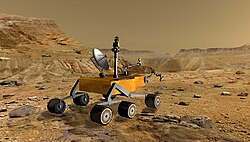MSL MMRTG loading 2011-7899
Autor/Urheber:
Department of Energy/Idaho National Laboratory
Größe:
2016 x 1164 Pixel (768479 Bytes)
Beschreibung:
In the Vertical Integration Facility at Space Launch Complex-41 on Cape Canaveral Air Force Station, the multi-mission radioisotope thermoelectric generator (MMRTG) for NASA's Mars Science Laboratory (MSL) mission, secured to a turning fixture, is positioned on the radioisotope power system integration cart (RIC). The MMRTG will be installed on the Curiosity rover with the aid of the RIC. The MMRTG will generate the power needed for the mission from the natural decay of plutonium-238, a non-weapons-grade form of the radioisotope. Heat given off by this natural decay will provide constant power through the day and night during all seasons. Curiosity, MSL's car-sized rover, has 10 science instruments designed to search for signs of life, including methane, and help determine if the gas is from a biological or geological source. Waste heat from the MMRTG will be circulated throughout the rover system to keep instruments, computers, mechanical devices and communications systems within their operating temperature ranges. Launch of MSL aboard a United Launch Alliance Atlas V rocket is scheduled for Nov. 25. For more information, visit
http://www.nasa.gov/msl.
Weitere Informationen zur Lizenz des Bildes finden Sie hier. Letzte Aktualisierung: Fri, 15 Mar 2024 07:02:38 GMT
Relevante Bilder
Relevante Artikel
Mars Science Laboratory
Mars Science Laboratory ist eine NASA-Mission im Rahmen des Flagship-Programms, die den Mars hinsichtlich seiner aktuellen und vergangenen Eignung als Biosphäre erforscht. Hierzu wurde auf der Oberfläche ein weitgehend autonomer Rover mit dem Namen Curiosity abgesetzt, der mit zehn Instrumenten zur Untersuchung von Gestein, Atmosphäre und Strahlung ausgerüstet ist. Zu deren Analyse kommen neben einer großen Zahl unterschiedlicher Spektrografen auch Kameras und meteorologische Instrumente zum Einsatz, welche die Messdaten für die Auswertung zur Erde schicken. Mit einer Masse von 900 kg und der Größe eines kompakten Kleinwagens war Curiosity bis zur Landung von Perseverance im Februar 2021 das schwerste von Menschen geschaffene Objekt auf der Marsoberfläche und löste die Viking-Tochtersonden mit je knapp 600 kg ab.
.. weiterlesen










































